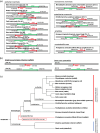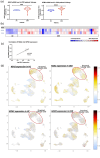Co-regulation and synteny of GFM2 and NSA2 links ribosomal function in mitochondria and the cytosol with chronic kidney disease
- PMID: 39396937
- PMCID: PMC11476648
- DOI: 10.1186/s10020-024-00930-8
Co-regulation and synteny of GFM2 and NSA2 links ribosomal function in mitochondria and the cytosol with chronic kidney disease
Abstract
Background: We previously reported aberrant expression of the cytosolic ribosomal biogenesis factor Nop-7-associated 2 (NSA2) in diabetic nephropathy, the latter also known to involve mitochondrial dysfunction, however the connections between NSA2, mitochondria and renal disease were unclear. In the current paper, we show that NSA2 expression is co-regulated with the GTP-dependent ribosome recycling factor mitochondrial 2 (GFM2) and provide a molecular link between cytosolic and mitochondrial ribosomal biogenesis with mitochondrial dysfunction in chronic kidney disease (CKD).
Methods: Human renal tubular cells (HK-2) were cultured (+/- zinc, or 5mM/20mM glucose). mRNA levels were quantified using real-time qPCR. Transcriptomics data were retrieved and analysed from Nakagawa chronic kidney disease (CKD) Dataset (GSE66494) and Kidney Precision Medicine Project (KPMP) ( https://atlas.kpmp.org/ ). Protein levels were determined by immunofluorescence and Western blotting. Cellular respiration was measured using Agilent Seahorse XF Analyzer. Data were analysed using one-way ANOVA, Students' t-test and Pearson correlation.
Results: The NSA2 gene, on human chromosome 5q13 was next to GFM2. The two genes were syntenic on opposite strands and orientation in multiple species. Their common 381 bp 5' region contained multiple transcription factor binding sites (TFBS) including the zinc-responsive transcription factor MTF1. NSA2 and GFM2 mRNAs showed a dose-dependent increase to zinc in-vitro and were highly expressed in proximal tubular cells in renal biopsies. CKD patients showed higher renal NSA2/GFM2 expression. In HK-2 cells, hyperglycaemia led to increased expression of both genes. The total cellular protein content remained unchanged, but GFM2 upregulation resulted in increased levels of several mitochondrial oxidative phosphorylation (OXPHOS) subunits. Furthermore, increased GFM2 expression, via transient transfection or hyperglycemia, correlated with decrease cellular respiration.
Conclusion: The highly conserved synteny of NSA2 and GFM2, their shared 5' region, and co-expression in-vitro and in CKD, shows they are co-regulated. Increased GFM2 affects mitochondrial function with a disconnect between an increase in certain mitochondrial respiratory proteins but a decrease in cellular respiration. These data link the regulation of 2 highly conserved genes, NSA2 and GFM2, connected to ribosomes in two different cellular compartments, cytosol and mitochondria, to kidney disease and shows that their dysregulation may be involved in mitochondrial dysfunction.
Keywords: Gene expression, diabetic nephropathy, chronic kidney disease, mitochondrial dysfunction; Mitochondria; NSA2; Protein synthesis; Ribosome biogenesis.
© 2024. The Author(s).
Conflict of interest statement
The authors declare no competing interests.
Figures







Similar articles
-
Nop-7-associated 2 (NSA2), a candidate gene for diabetic nephropathy, is involved in the TGFβ1 pathway.Int J Biochem Cell Biol. 2013 Mar;45(3):626-35. doi: 10.1016/j.biocel.2012.11.020. Epub 2012 Dec 7. Int J Biochem Cell Biol. 2013. PMID: 23220173
-
Elevated levels of renal and circulating Nop-7-associated 2 (NSA2) in rat and mouse models of diabetes, in mesangial cells in vitro and in patients with diabetic nephropathy.Diabetologia. 2012 Mar;55(3):825-34. doi: 10.1007/s00125-011-2373-4. Epub 2011 Nov 18. Diabetologia. 2012. PMID: 22095236
-
Nop-7-associated 2 (NSA2) is required for ribosome biogenesis and protein synthesis.Biochem Biophys Res Commun. 2018 Oct 20;505(1):249-254. doi: 10.1016/j.bbrc.2018.09.041. Epub 2018 Sep 20. Biochem Biophys Res Commun. 2018. PMID: 30243719
-
The Role of Mitochondria in Acute Kidney Injury and Chronic Kidney Disease and Its Therapeutic Potential.Int J Mol Sci. 2021 Oct 19;22(20):11253. doi: 10.3390/ijms222011253. Int J Mol Sci. 2021. PMID: 34681922 Free PMC article. Review.
-
Ribosome Biogenesis and Cancer: Overview on Ribosomal Proteins.Int J Mol Sci. 2021 May 23;22(11):5496. doi: 10.3390/ijms22115496. Int J Mol Sci. 2021. PMID: 34071057 Free PMC article. Review.
Cited by
-
A causal association between serum mitochondrial-related proteins and the risk of chronic kidney disease.Int Urol Nephrol. 2025 Jun 13. doi: 10.1007/s11255-025-04593-0. Online ahead of print. Int Urol Nephrol. 2025. PMID: 40512331
References
-
- Balamurugan K, Egli D, Selvaraj A, Zhang B, Georgiev O, Schaffner W. Metal-responsive transcription factor (MTF-1) and heavy metal stress response in Drosophila and mammalian cells: a functional comparison. Biol Chem. 2004;385(7):597–603. - PubMed
Publication types
MeSH terms
Substances
LinkOut - more resources
Full Text Sources
Medical

